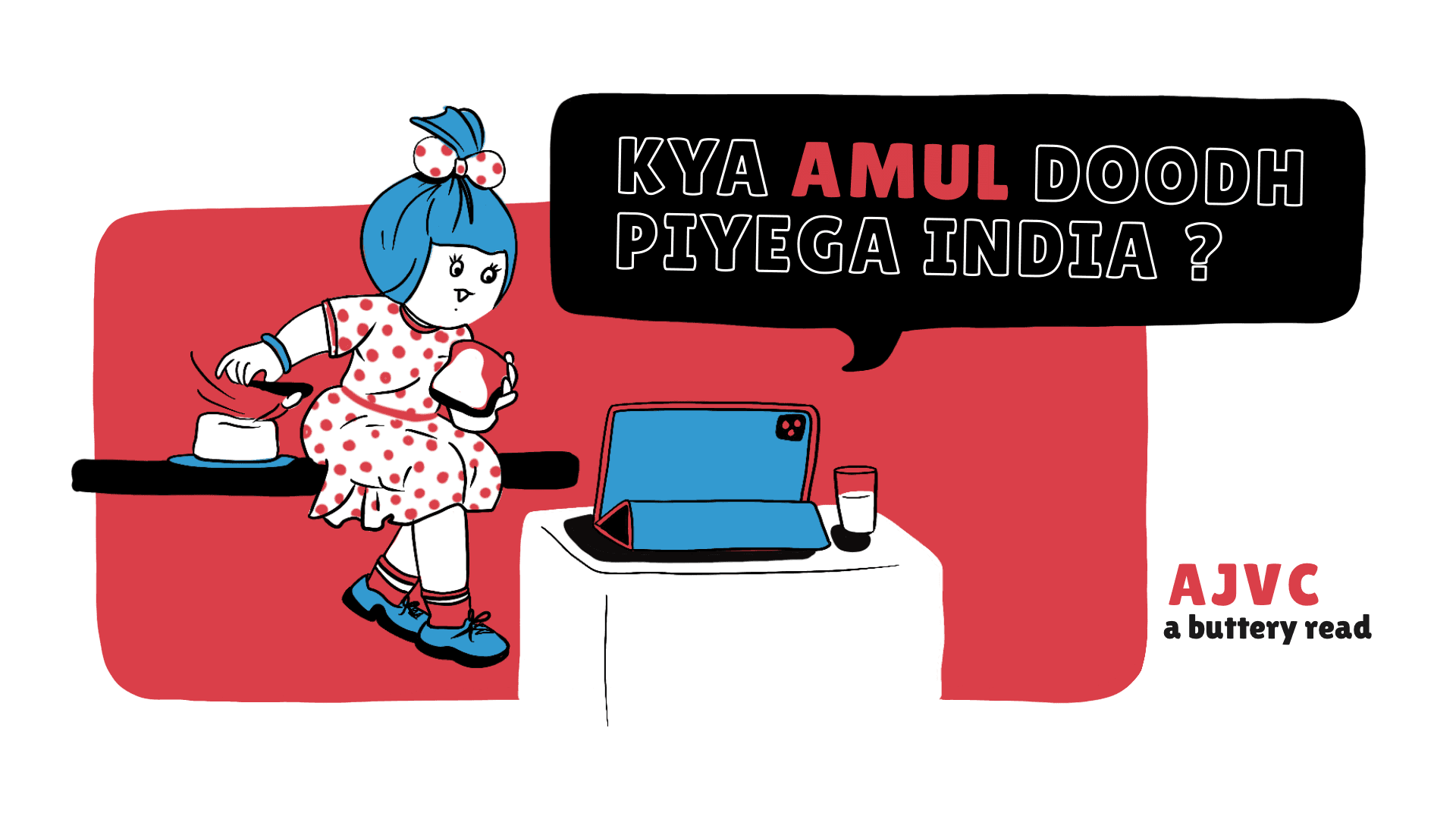
Jul 26, 2020
Will Amul’s Milk Run Win India’s Consumption Marathon?
Profile
Groceries
Retail
Food
Agriculture
Brand
B2C
Series H+
Last fortnight, Amul reported an annual revenue of more than 32K Cr ($5Bn), growing an incredible 20% at scale, and exploding during the lockdown.
Giving India Anand
The year was 1949, and India had just begun an independent era.
But with the shackles released, India had to build a nation from ground up. The key area of providing food to everyone was an enormous challenge. A new nation needed to be fed.
At this time, the quality of milk available in Bombay was worse than sewage water in London, and this situation would gnaw at a young man.
This young man, Dr. Verghese Kurien, was itching to complete his bond of service at the Government creamery at Anand to get his scholarship and move to the city of dreams, Bombay.
However, he was held back by a request from his friend, Tribhuvandas Patel. This request would begin to evolve into something bigger.
Dr. Kurien was asked to manage the Kaira District Co-operative Milk Producers Union. Kaira was a jointly owned cooperative set up to protect small farmers from the exploitative business practices of Polson, a dairy company that had a milk monopoly in India. Patel and Kurien were soon joined by HM Dalaya, and the three became the pillars of a unique cooperative movement.
The upstart was challenging a monopoly with a unique and different model.
While Patel brought together farmers to set up more cooperative societies, Dalaya used his technical expertise to run the cooperatives, and Dr. Kurien worked hard to create a cohesive brand for the cooperation.
In 1955, when Dr. Kurien was asked to select a brand name for the cooperation, he cleverly chose Amul because it was an acronym for the Anand Milk Union Ltd. It also drew from the Sanskrit word, amulya which means “priceless.”
In order to bring this dream to reality, The National Dairy Development Board (NDDB) was established at Anand in 1964. Through the NDDB, Dr. Kurien would end up scripting the largest dairy development programme ever drawn in the world.
It would popularly be known as ‘Operation Flood’ or ‘White Revolution’, and the startup’s plan would end up going places.
Ravanously Hungry
Dr. Kurien’s vision for the programme was simple.
Kurien wanted to offer thousands of small dairy farmers centralised marketing and quality control facilities. These were the missing links in the dairy economy at the time.
Little did he know that this would earn him the title of ‘Milkman of India’.
The ‘White Revolution’ programme which kicked off in 1969-70, set up Amul as a ‘model’ which was replicated countrywide to spawn similar success. The model, which came to be known as the ‘Anand Pattern’, would operate at three levels.
A dairy cooperative society at the Village level would be responsible for collecting milk, the District milk union to which the village dairy was affiliated procured and processed the milk, and the State milk federation markets the milk and milk products.
The programme established milk producer cooperatives in villages and made modern technology available to them.
The objectives of this programme were to increase milk production, augment rural incomes and cut out the middle-men. This allowed milk producers to benefit from the profits of milk marketing.
The importance of the program lay in its focus on small rural producers. Lucrative opportunities would not always be available in Indian villages which made dairy an attractive option for villagers.
Due to its low capital requirement, short operating cycle and steady returns, the dairy industry rapidly grew in popularity among marginal and small farmers.
Within 30 years, it doubled the milk available per person in India and made dairy farming India's largest self-sustainable rural employment generator. All this was achieved not merely by mass production, but by production by the masses.
Nearly 70MM Indian households had 98MM cows and buffaloes. A majority of milk producers had one or two milch animals and these small producers account for almost 70% of the milk production. On average 22.5% of rural household income came from milk.
This supply chain built from ground up would be complemented by a clever marketing machine.
India Gates, Mega Bytes
Amul’s marketing juggernaut was gaining popularity in the early 90s.
With several iconic TV ads and growing popularity the brand was ready to scale. Thanks to their tech wizard H. M. Dayla, Amul was able to convert excess buffalo milk into powder.
The 1990s saw a lot of diversification in the ads with respect to themes as the Amul Girl started to adore Bollywood like we do, with quirky ads based on movie posters.
She welcomed Bill Gates when he visited India, embraced controversy with the infamous Mr. Coffee ad featuring Arbaz Khan and Malaika.

Amul was well on its way to become the taste of India, literally and metaphorically.The marketing machine was churning away making Amul a part of Indian pop culture.
This marketing push combined with supply chain strength, helped Amul transform India from a milk-deficient nation into the world's largest milk producer, surpassing the US in 1998. In just 10 years, milk supply increased from 17.5 litres to 52 litres per 1000 urban consumers.
As the Indian economy grew and disposable incomes rose, Amul scaled with the economy.
India boomed and the urban population demanded more milk products. While the Indian population grew at around 2%, milk production grew at an astounding ~4% resulting in a net increase in availability of milk of around 2%.
By the late 90s, Amul was owned by 12MM farmer members grouped into over 1lakh village level dairy cooperative societies.
The societies were grouped in 170 district-level unions spanning 338 districts. The unions made up 22 state-level federations that marketed the Amul brand.
But as consumer preferences changed, Amul had to innovate its product line.
Branded Love Bites
Based on a survey’s findings, Amul entered into ice cream, curd, paneer, cheese, and condensed milk.
By the early 2000s, Amul had launched 'Real Ice-cream,' branded yoghurt, packaged milk, mozzarella cheese, coffee products, tapping into the growing and changing consumer demand.
It was evident that their great distribution would help any product launch.
With the state-level federations gradually expanding its distribution reach, Amul was able to expand its product offerings and capitalize on the opportunity by understanding evolving consumer preferences.
Over the first decade of the 2000s, Amul’s products would perform different functions in the cooperative’s machine.
The anchor products of milk, butter and cheese would become cash cows. These would drive the bulk of revenue and profits. Ice creams and ghee would be innovations that would show high growth, becoming stars.
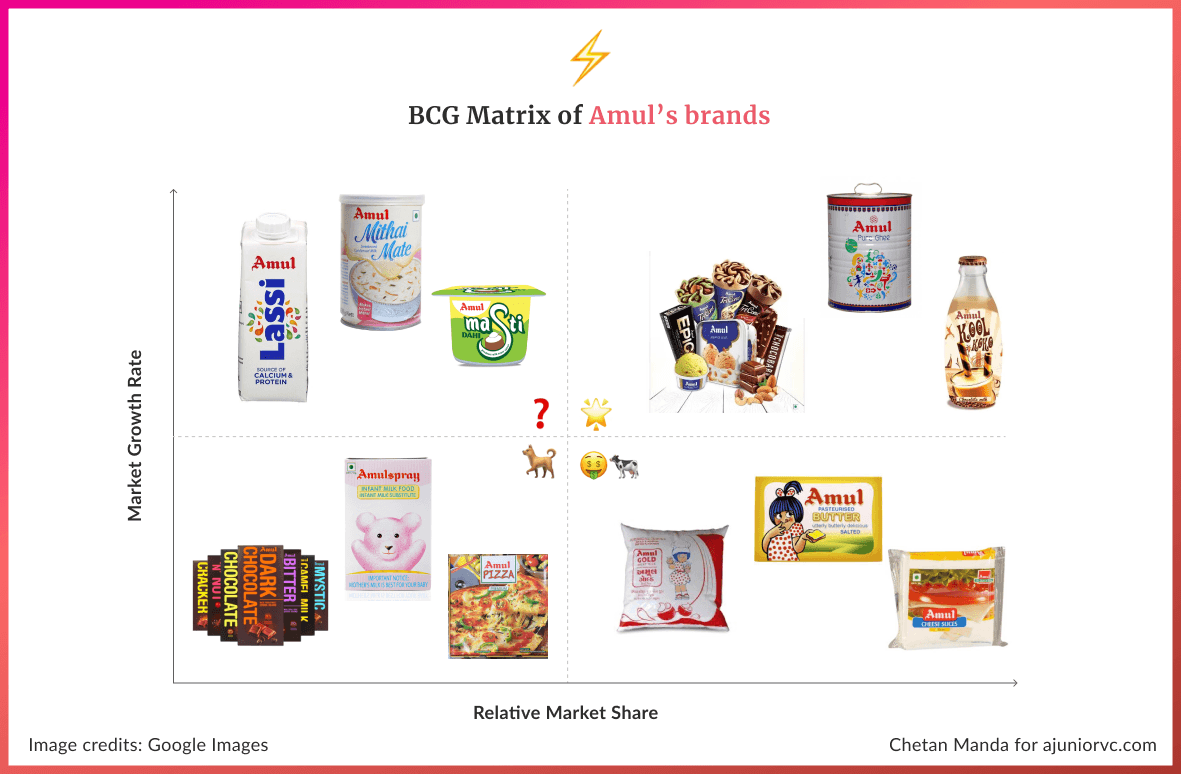
But not all of Amul’s product innovation would be well received.
Products like Lassi and Masti Dahi would remain question marks, challenged by entrants such as Danone. The foray into chocolates and pizza cheese would be tough, challenged by more focused competition in those categories.
Dominating niches for upstarts is easier than a everybody’s behemoth, as Amul would realize. Towards the end of the decade Amul would begin to slow down, and the struggles would spill over into Amul’s boardroom.
India’s Milkman was becoming increasingly unpopular, having helmed the company for close to 50 years.
Yeh Taj Nahi Jukega
Amul was in a quagmire, and it was unlike anything it had seen.
From 2000 to 2005, India’s GDP growth would outstrip Amul’s, a rarity for the giant. As sales stagnated, frustration and resentment grew within the organization.
Amul was no longer a milk upstart, but a brand of national importance. Politics was played, with actual politicians jostling for a share of the pie, pointing out fingers everywhere.
In 2006, Kurien was the one to take the fall, eased out of his chairmanship.
Over the next few years, the chairmanship would move towards politicians such as Parthi Bhatol, who would helm the cooperative for the latter part of the decade. But the steadying hand actually executing would move to an Amul lifer, who had been with Amul since 1982.
Amul was the only company RS Sodhi had worked with for almost 30 years. Being promoted to managing director in 2010, he would begin to start waking up the sleeping giant.
The changes would be across the supply chain to new launches, and were now fuelling Amul’s growth both domestically and globally.
In the dairy industry, one cannot grow only by putting up more plants as the raw material is not easily available. Amul’s strategy to achieve this goal has been of 3Es – Expansion in milk procurement, milk processing and marketing.
Keeping this as core by FY 2014-15, Amul brand turnover grew from Rs 8,005 crore to Rs 20,733 crore in five years, an astounding cumulative average of growth rate (CAGR) of 21%.
Mr. Sodhi’s push would make Amul grow 2.5x in 5 years, the most in its entire history. A strong part of this push was doing something Amul had not prioritized before.
Imagining in India, selling to the world.
Becoming a Thoroughbread
Amul would target the millions non resident Indians to fuel revenue growth.
In 2016 Amul partnered with Amazon to cater to the demand for ghee of the overseas audience.
Given supply chain constraints, there are two types of products for export in Amul’s portfolio. The first is packaged consumer products – mainly for the Indian diaspora such as Amul Butter, Amul Cheese and Amul Ghee.. The second are commodities like milk powder and white butter.
Export of commodities depends on international prices and in few cases it is not viable for milk products given the volatility in prices and incremental costs. To scale the global business, Amul began to set up production facilities outside India.
Exports began to grow rapidly to 250 crore in 2016.
By 2017 Amul owned two small production bases in US to produce ghee, shrikhand, etc. and had plans to set up a production facility in Europe.
With this push, Amul was already outpacing other FMCG companies.
While most FMCG companies were showing single digit growth of 6-7%, Amul registered a 17.5% jump in FY 2017. In FY2010, turnover was around Rs.8,000 crore, which in FY2017 grew to Rs 27,043 crore at a CAGR of 20%.
This is no mean feat, as it would outstrip global brands like Unilever and P&G. The key factor driving its growth was the trusted brand it had built.
For the consumers to trust the brand, the brand should never “cheat” its customers. For a farmer to believe in his customer, he should never feel “cheated”.
Stressing on this philosophy, Amul believed, “Marketing is not for business but for development of the most under-privileged society of India.”
Faith and trust is not an overnight job. It would come from decades of consistent messaging.
Umbrella branding strategy has worked very well for Amul - all its products are under one single brand. And Amul has done well, sticking with the Butter Girl for the last fifty years, against the advice of several advertising agencies. It would stick to one, DaCunha.
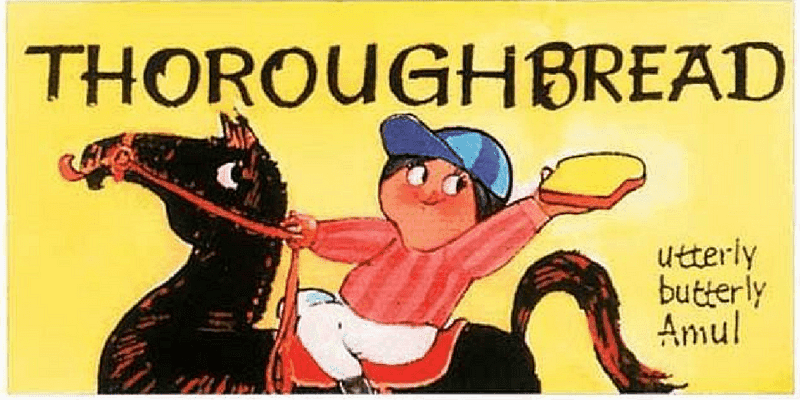
This kind of consistency results in powerful customer acquisition economics. Amul’s marketing spend would remain below 3% of its annual turnover all through 2018. For any business of this scale, this ratio sounds “utterly, butterfly, delicious”. New age D2C brands have 20-30% of their revenues as their ad-spend budget, which can learn a lot from Amul’s marketing efficiency.
Another powerful tool that works against a strong brand recall is customer segmentation. Amul does not believe in segmentation, throwing most marketing learnt in BSchools out of the window.
Amul butter is consumed by millionaires living in big cities as well as by autorickshaw drivers living in small towns, there is one uniform perception of the brand.
Amul has exhibited dynamism by experimenting with new forms and ways of storytelling. For instance, Amul dabbled with coloured print ads in the seventies and made a film titled ‘Manthan’ to educate the people about its brand.
Amul’s continuous innovation would allow it to build a unique business, that chased profits, purpose and passion, all at once.
Yeh Roasti Hum Nahi Todenge
Amul’s organizational structure as a cooperative is deliberate and allows building the right incentives.
It seems like a curiosity that Amul isn’t a public company, but its structure as a “loosely” private company allows it to take care of everyone in the ecosystem.
Through its nation-wide connected network of 18,700 village milk co-operative societies, Amul procures 23 MM litres of milk per day from 3.6MM milk producer members, representing 18 member unions covering 33 districts. It operates from 62 sales offices and has a network of 10K dealers and 1MM retailers, one of the largest such networks in India.
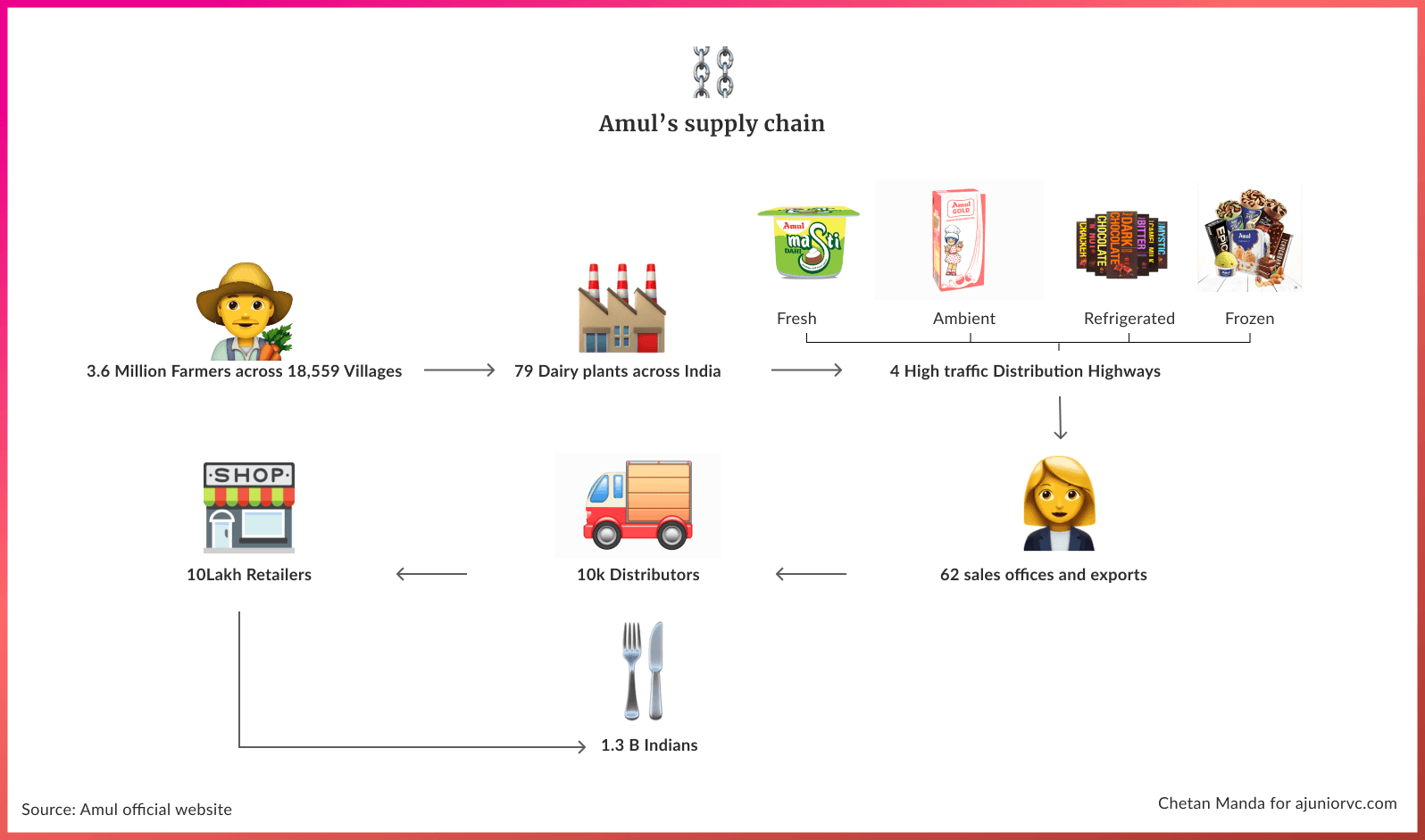
If any investor looked at the P&L of Amul, they would be astonished to see a COGS of 95%.
But the unnaturally high ratio of 95% of sales, with this ratio remaining steady over the previous five years. This indicates that as a cooperative, Amul’s primary motivation had been to plough earnings from the sale of milk products, back to the milk producers, thus promoting a virtuous cycle of sell-profit-reinvest.
This model excludes intermediaries in the form of middle-men from the picture - the co-operative collects the milk directly from the farmer’s gate.
The co-operative helps the farmers to get remunerative price as well as a continuous market for the milk. In addition, the cooperatives also have a share in the company’s profit at the end of the year.
The end price of Amul products are decided by Gujarat Cooperative Milk Marketing Federation (GCMMF). Competing against multinationals with deep advertising pockets, Amul’s penchant for quality at affordable prices had made it stay relevant even after 70 years.
Milk being a perishable commodity it is necessary to preserve it properly. To maintain its quality, the society maintains a Bulk Milk Cooling system which preserves the milk below 40C.
This also reduces the expenses of the transportation as the society which has this unit the van goes only once a day to collect the milk. Further to prevent the sourage of the milk the union has its own chilling centers which help in preserving the milk procured from the far off societies
For Kaira District Cooperative Milk Producers Union (one of the 18 unions supplying milk to Amul), analysis shows that inward freight (transportation of milk collected from individual milk producers) charges for FY19 had been 1.5% of its revenues, while outward freight (distribution of milk ahead) accounts for 0.5%.
Since Amul is a collection of 18 such unions spanning the nation, this 2% serves as a good proxy for the overall distribution costs incurred by Amul to keep its enormous supply chain running.
For FY20, with an estimated annual revenue run-rate of INR 50K Cr, even at a conservative marketing spend of 3%, Amul would spend INR 1500Cr.
Assuming half of India’s population is an Amul customer (a conservative 40% market share), and a family size of 4, there would be 12.5Cr Indian households who buy Amul products yearly.
Assuming a purchase is done every other day, that gives a daily AOV of ~INR 30 (50K crore revenue/(12.5 crore households*150 days in a year). This is roughly the price of a 0.5 Ltr pouch of milk or a regular cone ice cream. For a lifetime of 20 years, lifetime value (LTV) of that household is ~INR 90K or INR 30 daily * 150 days of purchase a year * 20 years.
Assuming a 5% annual churn rate, and that the entire marketing spend is aimed at acquiring new customers, CAC for Amul would be INR 2.4K for a household. This results in an astonishing LTV/CAC of 35, close to the ratio of revenue to marketing for the behemoth.
It would be well positioned for the end of the decade.
Building an Untied Kingdom
Much before farm-to-fork became mainstream, Amul was ideating and executing a C2C (Cow to Consumer) and B2C (Buffalo to Consumer) supply chain.
A key growth strategy for Amul continues to been product expansion. The massive distribution it has allows it to do so. Amul considers the inherent strength of its existing portfolio and the synergies which can be derived through diversifying into adjacencies.
In FY19, it launched value-added products such as flavored milk, camel milk, fruit based Amul Tru (combo of milk and fruit) and new range of kulfis. It also launched Happy Treats brand with products such as French fries, aloo tikki and Hash Brown
Expansion in markets and beefing up milk capacities across India have been other key growth drivers.
Be it a hail or storm, Amul has withstood the test of time always. In 2019. while most sectors (automobile, consumer goods) witnessed a consumption slowdown, Amul stayed unaffected with its MD RS Sodhi remarking that ‘nobody has reduced consumption’
Amul’s turnover in FY20 grew 15% to reach Rs. 38,550cr ($5.1B) and continued its upward growth trajectory. Despite turbo-charged growth, profitability had never nosedived. Profit after tax margins have been steady at 0.2% for the last 8 years.
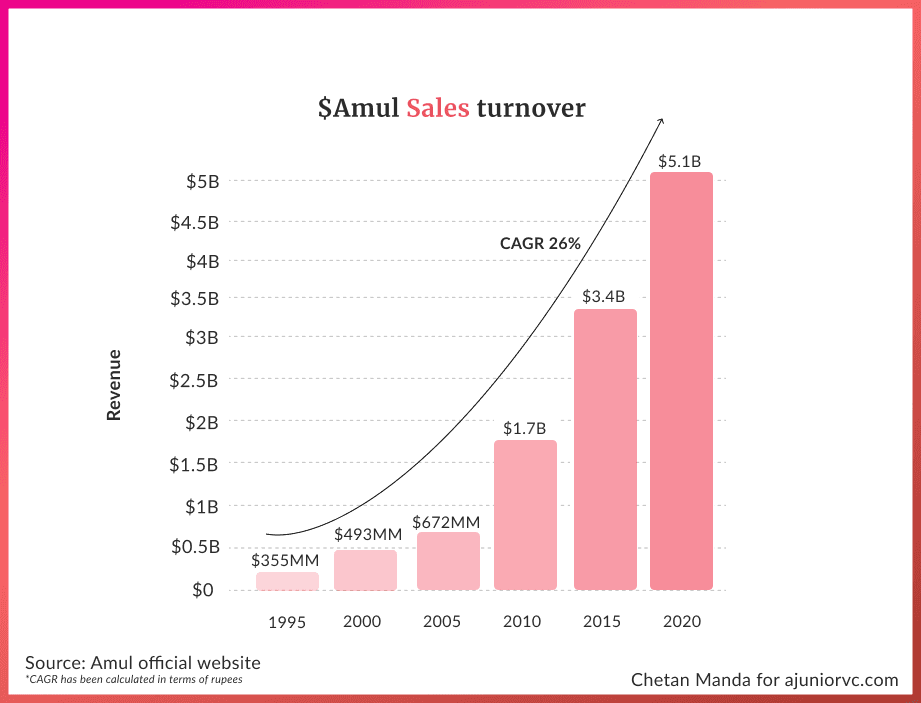
Amul has helped other cooperatives through sharing its expertise and technical knowledge and helped shape the overall ecosystem. ‘Cooperation’ rather than ‘competition’ has been the spirit with Amul recognizing itself as an elder brother to help out other regional dairies.
In Mar 2020, three milk unions Banas Dairy, AmulFed Dairy and Amul Dairy became billion-dollar entities, the true unicorns we need to celebrate.
Amid the fear and panic imposed from the complete lockdown, one of the first things AMUL did was to assure its consumers that milk supplies will remain normal.
One might have thought that the closure of restaurants, hotels, and cafeterias (HoReCa) during the lockdown will adversely affect revenues. But contrary to expectations, the rise in household consumption has put any fear of slowdown in sales to rest.
‘Never let a good crisis go to waste’ is a popular phrase and Amul has truly exemplified it. Sensing changed consumption patterns and growth trends; it has quickly re-assessed its product launch pipeline.
In the first four months of FY21, it has launched an astounding 33 new products, the highest in a quarter.
When the foundation is rock solid, not even a hurricane cannot disrupt a house. The deep rooted distribution network has stayed resilient during the lockdown.
To ensure that there was no supply disruption, it paid casual workers Rs. 100-125 extra and gave distributors an extra 35 paisa incentive per liter of milk. It also made food and stay arrangements for workers inside dairy plants to avoid any labor shortages. Fear was assuaged by providing warm drinking water and Ayurvedic medicines to its workers.
Amid all this, it has remained laser focused to ensure its main stakeholders- farmer members of dairy cooperatives were protected and paid around 80% of the consumer rupee. And in all this, it has managed to pay out Rs. 12K crore ($1.6B) in cash to dairy farmers who supplied raw milk
Amul has also taken advantage of the fact that consumers switched to paying premium for safety which has increased demand for pouched milks. Moreover as unorganized players and smaller cooperatives froze, Amul’s milk procurement from farmers increased 15%
Contrast it against the fact that most vegetable and fruit producers nationwide had to dump their produce with pittance as prices were paid for their blood and sweat.
Buddy Buddy Batein
The one thing which unites India is their love for food, and Amul aims to capitalize on it.
MD R.S. Sodhi expects a 15-16% revenue growth in FY21 at a time when other businesses have struggled to stay afloat much less deliver any topline growth.
Amul with its fantastic brand loyalty, deeply entrenched supply chain and distribution network and category, region diversification has remained at the front and center to win big.
While the company has reaped its magic in the dairy industry, it has a compelling opportunity to continue to expand in adjacent food categories.
It plans to expand its presence in packaged sweets beyond Gulab Jamun and Rasmalai. It also entered the branded edible oils segment earlier this month with its launch of ‘Janmay’ (newly born) brand with five variants.
Exports are also looked at as the next growth frontier.
Amul wants to go deeper and battle it out with regional brands available in friendly neighborhood stories. Its Locate Amul app which is currently used by internal sales executives and distributors could eventually be expanded for hyperlocal deliveries.
It recognizes the future problems which the dairy industry might face and is proactively working to counter its effect. The second generation farmers do not find dairy farming sexy enough and no educated girl wants to marry a dairy farmer with 20-30 animals quips RS Sodhi.
Amul is working to make dairy appealing, modern and contemporary by providing machines, attractive sheds, and computerized machines to prompt a change in mindset.
For it to replicate its playbook in other industries, it will require trained professionals. This will need setting up of dedicated institutes such as IRMA which was envisioned by Kurien four decades back
A bigger tectonic shift can unfold if it can replicate its cooperative model in dairy to fix the fruit and vegetable supply chain in India.
Amul is a remarkable story on how the basic philosophy of a true cooperative built on steely determination and flawless execution can revolutionize an entire sector. It is a lesson in creative farmer cooperative leadership model in the global food system.
As it enters 2020, it is now neck to neck with Hindustan Unilever’s 38K crore revenue, and looks set to beat HUL in the next 3-5 years. It is a legendary story to learn from for India’s budding consumer startups.
If anyone is looking for an example of an ‘Atma nirbhar’ brand from India, look no further than Amul.
As Amul enters the new decade, it could be definitive for India’s consumption story.
Written by: Abhinay, Aviral, Chetan, Keshav, Mazin, Raj
Audio Version: Behind the Scenes with AJVC
As usual, we have done a behind the scenes format with the writers and host Mazin